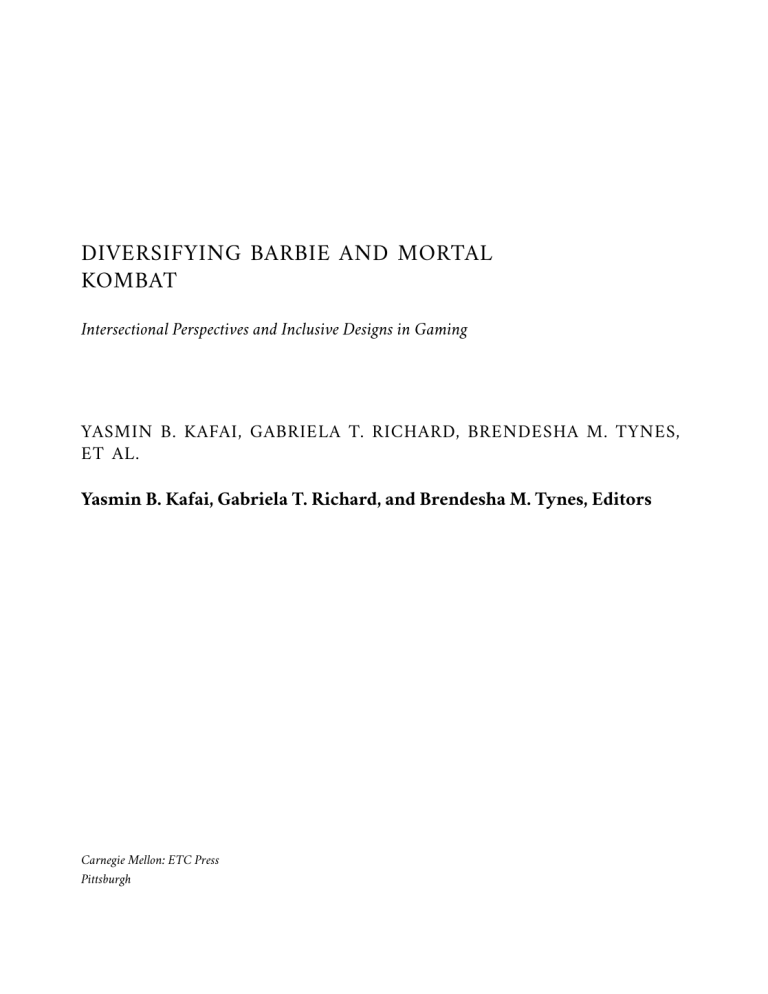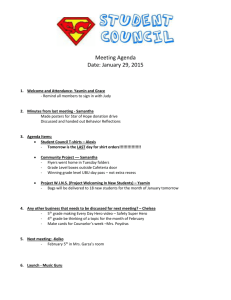
DIVERSIFYING BARBIE AND MORTAL KOMBAT Intersectional Perspectives and Inclusive Designs in Gaming YASMIN B. KAFAI, GABRIELA T. RICHARD, BRENDESHA M. TYNES, ET AL. Yasmin B. Kafai, Gabriela T. Richard, and Brendesha M. Tynes, Editors Carnegie Mellon: ETC Press Pittsburgh Copyright © by Yasmin B. Kafai, Gabriela T. Richard and Brendesha M. Tynes, et al., and ETC Press 2016 http://press.etc.cmu.edu/ ISBN: 978-1-365-83026-6 (Print) ISBN: 978-1-365-83913-9 (eBook) Library of Congress Control Number: 2017937224 TEXT: The text of this work is licensed under a Creative Commons Attribution-NonCommercial-NonDerivative 2.5 License (http://creativecommons.org/licenses/by-nc-nd/2.5/) IMAGES: All images appearing in this work are property of the respective copyright owners, and are not released into the Creative Commons. The respective owners reserve all rights. CHAPTER 9. BLACK AND FEMALE IN TECH An Intersectional Guide for Intersectional People BY SHANA T BRYANT Let me tell you a story. Six. That’s how many I counted.1 It was the Game Developers Conference (GDC), the year was 2008, and it had not gone unnoticed: the lack of Black women in attendance. “Where are they? And why aren’t they here?” Six. The paucity of diverse faces at even premiere events for industry professionals came as no surprise. At the time, it was not very much different my everyday working in games; and in the years since, change has been slow. Black women in tech are rare. And being rare, we’re alternatively coveted and/or shunned. It’s a function of systems and structures far larger and more complex than I am going to attempt to frame in this piece. Instead, I just want to talk about my experiences as one of those six Black female faces, what I’ve learned, and well, how to deal. Oh, and I want to talk about intersectionality, because my life in tech has been a big ole ball of intersectional dealing. But first… OBLIGATORY BACKSTORY I’ve been a developer in the games industry for going on 14 years now. From EA to Midway (rest its soul) to Capcom and beyond, I’ve tested or produced or canceled DIVERSIFYING BARBIE AND MORTAL KOMBAT 133 games in just about every genre out there (except MOBAs, I haven’t gotten to MOBAs yet). And I’ve loved every minute of it. Well, wait, no no. That’s quite overstated. There are some minutes I could have definitely done without. But if we’re talking simple majorities, I’ve loved most minutes. Each developer has its own style, its own culture, its own branding and competencies, its own ways of doing. Your EAs do your big-budget, well-funded, carpet-bombmarketing annuals. Your Capcoms do your fighting games and have the zombieinfected shooters on lock. It’s not complicated. There are constants. And for me — a game developer who also happens to be Black and a woman — there were certain things I typically could count on regardless of the name on the building. The desks will have toys. Toys. Toys! So many TOYS! Toys for hours. Toys for days. It was a toy wonderland. A perfect justification for the boxes of random figures I’d collected over the years. Now, they had a home on my desk. Jeans and t-shirts are the (un)official uniform. And everyone wears the uniform. There’s the occasional regional or seasonal audible (shorts and flip-flops in the summer, maybe hoodies when it’s a bit chillier). But by and large, pick any 10 game devs at random, and you’ll have at least 5 hipster tees and more than a few stonewashed jeans. Everyone is white and male. Well, not everyone everyone, but I can make this completely irresponsible statement, and it’s still more correct than not. (Official numbers support that.) But being not white and not male, I am remarked occasionally as somewhat of a rare find, maybe even a legendary rare (to extend a nerdy reference). If there’s one thing about being a “girl who plays games,” it’s that it’s common enough to be unremarkable, but not quite common enough to not be remarked upon. And with the Blackness modifier, I was practically a unicorn. CHAPTER 1: THE INVISIBLE VISIBLE I walked excitedly into the development studio, eyes wide, teeth flashing. This was it! This was my chance. This was my dream – to work in games, to make games. I’d certainly been pursuing a game dev career since before game dev programs were 134 YASMIN B. KAFAI, GABRIELA T. RICHARD, BRENDESHA M. TYNES, ET AL. colloquialized into university programs, but I’d had little expectation that a 22-yearold me would find herself a part of production on one of the most recognized franchises of all time. To many, games were a quote-unquote “boys’ hobby.” As a kid, my teachers would periodically and somewhat hamfistedly remark on the childishness of this pursuit of mine. It didn’t dissuade me. Even though I didn’t know particularly much about how games were actually made in the real world, armed with a 4-year-degree, I was now reasonably set up to start learning by doing. After a week of training and orientation, I met my teammates. A rough and tumble group of gents, clad in caps, sneakers, and t-shirts (or the occasional jersey), quite often sporting sports insignia of one of 32 national teams. They welcomed me to their space, happily, if not a bit cautiously. And I’m careful to say their space, as up until my hiring, it had been months since a woman had even walked the floors. My training class had brought the male to female ratio of the department to 300:2. That’s three-hundred men and two women. Now, even new as I was to it, it came as no surprise that my fellow game folk were predominantly male, predominantly white. The same was easily said of most every programming, math, and science class I’d taken over the preceding four to five years. The same same was just as easily said of the typical “gamer,” at least as the term was stereotypically defined back then. Eighties and 90s marketing materials would conjure to mind the young, rebellious snaggletoothed teen rogue in a typical middleclass white household getting his EXTREME (or X-TREME!) gaming on. There was no room in print ads for me. So one might say I wasn’t exactly expecting some kind of radical shift in the demographic makeup of my new environs, even as I transitioned from enthusiast to developer. That said, I didn’t expect the professional landscape to be quite as unbalanced as it would ultimately prove to be. But it seemed as if I would have to do what I always did — which was to simply become accustomed to existing in spaces with increasingly fewer people who looked like me. Months passed, and the initial shock of letting an outsider in wore down. And we had some fun. There was the more-than-occasional “locker room moment,” of course (perhaps to be discussed at some future time), but on the whole that space yielded mostly interactions that fell within expectation. DIVERSIFYING BARBIE AND MORTAL KOMBAT 135 It’s here that I have to step back and admit I am terrible with names. In my present day-to-day, I’m rarely seen without a pen and pad, jotting down notes and mnemonic needs to keep all the details neatly arranged. Back then was the same. Even months, years in, I never quite learned the monikers of all twenty-five dozen of my colleagues, but amusingly, they all knew me. Now, I would like to ascribe my infamy to the thoroughness of my research or the sharpness of my wit, and those who truly know me might also list those as memorable qualities; but I also know that I was wellknown, because simply put, I was easy to pick out. Among waves of masculinely coded faces were only two not so masculine, and even among those, only mine was of a browner complexion. There was a certain comfort to being so easily recognizable but also a certain unease. I was never allowed the first impression, never permitted the making of acquaintance. Since I was already a “known,” many introductions merely skipped my half of the niceties, as though a conversation had already begun without my presence or involvement “Hi, Shana! I’m Tom. I was told you could help me repro this bug.” “Hi, Shana! I’m Dick. Did you get the builds from TLA this morning?” “Hi, Shana! I’m Harry. Can you do blah, blah, and blah?” My introduction was already spoken for and with it, so went a little of my right to self. After all, that first impression is so critical in our society. When you don’t get the privilege of self-presentation, you’re stuck wondering about the margins. “What do they know about me?” “Who did they hear from?” “How did they say it?” “What are they assuming?” It’s unnerving in a way that is difficult to describe, but basking in the minorest of minor organizational celebrity led me to an assumption of my own – the assumption that knowing my face (or at least knowing the color and dial of my face) was in any way equivalent to knowing my work. That sense of familiarity is a placebo. It inadvertently hints toward established professional relationships where there are none, and good will where there may be none. That false familiarity can scuttle the foundation on which a professional relationship is built. 136 YASMIN B. KAFAI, GABRIELA T. RICHARD, BRENDESHA M. TYNES, ET AL. So perhaps I was careless. (I was careless.) Perhaps I assumed. (I did assume.) But all that careless assumption didn’t account for what was reasonably noticeable when viewing our management staff all lined up in a row. Forty+ managers. Zero women. *** Fast-forward two years. By this time, our ratios were on the order of 350:9. Nine women on a payroll that two years previous had zero was impressive on the curve, but not entirely impressive outside of the vacuum. I was still young, mind you, in age, experience, and career. So even though I noticed this (and thought it a bit odd), I wasn’t yet savvy enough to challenge the logic they used to justify our very homogenous managerial staff. “We are a meritocracy,” they decreed, in words not quite as explicit as those Meritocracy. You know the word. It is the tech industry’s most resilient half-truth, created to combat the existence of a Glass Ceiling. “If women/minorities aren’t making it, it’s because they’re not good enough. Bootstraps. Bootstraps!” Watching my male colleagues, some younger, many with less experience and fewer noticeable accomplishments lap my female colleagues in career advancement, finagle their way into career paths for which there was no apparent entry ramp, fail to ever fall in a direction besides up, was both disappointing and sobering. And speaking with my female colleagues, they heard it. They saw it. There was a surgical sameness to all of our review feedback: “We’re afraid you won’t be able to give ‘the hard message,’” they said. Put another way, “You’re too nice, ladies, you’re too nice.” Am I alleging some massive anti-woman conspiracy? Nothing so salacious. No, it’s more likely a pattern that merely evolved out of common thoughtlessness and convenience. In general, thoughtlessness and convenience that can be blamed for many a marginalizing event. DIVERSIFYING BARBIE AND MORTAL KOMBAT 137 Exhibit A: “Katie wants to be a manager…but Katie is SO NICE, and sometimes managers have to be mean. So even though I’ve never seen or examined her work, her niceness would probably get in the way if she ever needed to be mean, soooo SORRY KATIE. Time to promote Peter. He’s a regular jerk.” Since Black women in tech are often simultaneously invisible by gender and highly visible by race, we ought to consider the effect that intersectional -ism’s have on the career and livelihood of those living at that corner. But in too eagerly recognizing our differences, mistakes are made… CHAPTER 2: ON THE MATTER OF KEEPING GATES “So what do you think about working with all these Asians?” he asked the question somewhat casually (too casually) as he entered the room and sat down, sipping a late afternoon coffee. “Um, it’s just like working with anyone, I guess,” I stumbled. I stuttered. The question was so bold and so boldly inappropriate that my brain was still struggling to concoct an answer that was equally and righteously bold while also being interviewappropriate. Oh, didn’t I mention? This was in an interview. My answer wasn’t adequate. No, not at all. And I still occasionally look back and kick myself. Why didn’t I say this? Why didn’t I say that? Why didn’t I just get up and walk out of the interview room? But I didn’t say any of those things. And I didn’t get up and leave. And the interview continued. “So I want to ask…” he pauses and turns to the side. Under his breath, he whispers to himself and to me, “I need to figure out how to ask this without getting myself in trouble…” He looks back up, newly confident, “Are you going to be able to call me and well, these guys on our bullshit?” I recognize this immediately. This is dog-whistling. This is the “Can you give ‘the hard message’, or will your lady-parts and lady-feels get in the way?” I know how to answer this one. I’ve almost literally been answering that question in one format or another for more than a decade. 138 YASMIN B. KAFAI, GABRIELA T. RICHARD, BRENDESHA M. TYNES, ET AL. *** Ever heard of “stereotype threat”? I hadn’t either; it’s an academic term, and one I just recently learned (Richard, 2015). That said, it describes well a common occurrence that I didn’t even know had a name. Stereotype threat (Steele & Aronson, 1995) is: “…when negative stereotypes of a gender or ethnic groups’ ability in a field or domain is elicited, explicitly or ambiguously, and causes stress, which undermines the stereotyped groups’ performance, regardless of actual skill.” Understood colloquially, it’s another result of gatekeeping — the old guard protecting their monopolization of the space, challenging your right to dare exist in it. It can be vague or overt, but is often the former, and it causes a constant layer of mental, emotional, and even physical stress that feeds into other well-termed phenomena, like that feeling that you really, really don’t belong (aka, imposter syndrome) and more. It’s common among people of color, women, and especially in uniformity-dominated environments. The tension is not merely self-induced. It’s a symptom clinically cultivated in and induced by tech culture spaces that are intentionally male-centric, some even to the point of being “women-unfriendly” or even “hostile.” Likewise, tech working environments are largely white-centric, some to the point of being “minorityunfriendly,” some to the point of being (racially) “hostile.” There’s a concept of “culture fit” that drives tech hiring culture. The idea is simple – “If we build a community of like-minded techies, we’ll create a culture where everyone fits. We’ll weed out dissent and conflict, and we get to work with people who we also think it’d be cool to hang out with (Bonus!).” But our system is flawed. Seeking people who are “just like us” in an industry that is in a shortage of minority affiliation is like crossing your fingers behind your back. At some point, the ideals of “diverse hiring” and “culture fitting” will always come into conflict, because the very idea of diversity implies disruption of the status quo. And disruption of the status quo is the farthest thing away from culture fit. In our current climate, “culture fit” and “diverse hiring” are not only mutually exclusive, but mutually destructive. DIVERSIFYING BARBIE AND MORTAL KOMBAT 139 *** It’s 2010. And I’m still counting. There are more Black women this time. Not many more, but more. I never lose count, question my numbers or my pace. I walk through crowd after crowd, but never am I once overwhelmed with the task. Never is there encountered a surprise flock of tanner-skinned colleagues who wildly throw off my tally. 24. 25. 26. I’m sure I missed a head here or there, but fine. Double my numbers. The result is still embarrassing for an industry so committed to diversity. Perhaps, we’re only committed to the idea of diversity? The sessions that year used all the buzzwords, checked all the boxes. • Inclusive design! • Diversity! • Bringing women into the fold! But as soon as the lights died down and the night life rose up, many of those same companies so committed to inclusion were throwing their annual parties, complete with neon-lit gogos on raised platforms. (I said it was 2010; perhaps, it’s 2013.2) There’s a saying about words and actions that I don’t need to complete, but this was more than a left hand/right hand problem; this was cultural. This was systemic. And cultures and systems are damn hard to change CHAPTER 3: THERE’S A GIRL OVER THERE… The day started like any other day. I came in, put my lunch in the fridge. I sat at my desk and tore into checklists. I saw unfamiliar faces milling about, making noise, doing things – unusual for a company where most spoken comments were tradesecrets. “…there’s a girl over there,” I’d heard some producer-type say. “See if we can get her.” I heard their inquiry. And moments later, it was “Shana, do you have a minute?” as they beckoned me aside. There was a special assignment for me today, if I wouldn’t mind just signing this here waiver/release form. I read it, asked questions. I signed. And before I knew it, I was sitting back in my chair, controller in hand, tapping away, faking a pass or calling an audible. A studio-quality camera was aimed directly at my 140 YASMIN B. KAFAI, GABRIELA T. RICHARD, BRENDESHA M. TYNES, ET AL. hands (or rather, my distinctly feminine manicure), and then turned to pan to my face. Here’s the thing about otherness. It is sameness with a spotlight always on it. It is being ordinary in exemplary ways. It is normalcy treated as though normalcy were fancy. I grew up in the non-diverse nerd-o-sphere of 80s and 90s pop-nostalgia. We weren’t far removed from Civil Rights (as a proper noun), feminism was second-wave, and words like intersectionality or political correctness weren’t even words yet. Television was just barely integrated, and our schools still weren’t. A little black girl in the South, if I weren’t an army brat living amongst other army brats, my playtimes would have been mighty different. I remember my childhood heroes. She-Hulk and Spider-Man. Claire Huxtable. Atreyu and Artax. Link and She-Ra. The Dread Pirate Roberts. I looked at my childhood toybox – a bastion of eclectic liberalism curated with very non-liberal intent. I had toys of all shapes, sizes, mechanism, and complexity, and I consumed media of all types of origin – from the nerdy to the spiritual. I remember my sister and I often being the only little black girls in our neighborhood, extracurriculars, and schools. And I remember hearing kids repeat the careless, racist thoughts that they’d no doubt absorbed from parents still resisting a newborn climate of integration and change. “Hey, Shana, my parents told me that Black people don’t have grass in their yards. Do you have grass in your yard?” Do you have grass in your yard…? *** It’s 2009. And there’s a line in the bathroom. I remember it clearly. I remarked on it. The other ladies remarked on it. I’d never been so elated to have to wait for a stall. It was an important (though inconvenient) landmark in our minds. But a line in women’s bathroom is only a line of women. It speaks only to the number of female bodies in attendance, not specifically Black females, so it doesn’t impact my annual and informal record-keeping. And for the record, my count reached double- DIVERSIFYING BARBIE AND MORTAL KOMBAT 141 digits that year. Looking forward, that number would stay in double-digits for several years hence. CHAPTER 4: HAPPY ACCIDENTS There’s something powerful about media. It is escapism and imagination. It is power fantasy. For people in the minority, media is often a place where we can find that fictional release. We can mine the escapist fantasy for characters to fictionally relate to, supplementing our daily lives that can be widely deficient of meaningful cultural interaction. Television and movies have long faced criticism of their diversity numbers both on and off the screen, but at least where mainstream cinema may falter, there still remain specialized networks and programming, catering to underserved demographics with entertainment featuring largely diverse casts. Games, on the other hand, have no handy analog. Games have no (and arguably need no) BET, but in the current landscape, underserved gaming demographics remain sadly underserved. Our games crudely cast the archetypical jock, the nerd, the slacker, and the girl, while people of color are generally relegated to fringes as NPC roles and/or the comedy relief. For videogames, there is no happy accident when it comes to inclusion or diversity. Faces on a screen have to be put there deliberately. Faces on a screen have to be colored deliberately. This means that diversity must always be a conscious decision, though it’s possible to make it a less deliberate one…but again, we’re talking about changing cultures and systems, and as already discussed, change is hard. Let’s put it this way. Representation matters. Which is why I signed that waiver. It’s often why I’ve allowed companies to parade my black skin and womanly features about semi-exploitatively. Diversity is important. I believe that to my core. But to companies, it’s often only the appearance of diversity that is important. The appearance of diversity is valuable. If a company can appear diverse, it can often reap the benefits of diversity without actually being diverse. Look at any employment application, and you’ll see the phrase: An Equal-Opportunity Employer Some companies incorporate it into their logos, throw it in their letterhead, or even plaster it all over their visitor badges. It’s a weird statement to constantly tout, especially when touted at companies as homogenous as any in tech. Diversity is a 142 YASMIN B. KAFAI, GABRIELA T. RICHARD, BRENDESHA M. TYNES, ET AL. buzzword. A two-dollar lark. A lacquered-up showroom with pizzazz and appeal, but once inspected, you see the paint running down the cardboard backdrop and pooling unevenly on the floor. Your otherness will be exploited (in recruitment, in video, and interview footage), and it is hardly ever to your direct benefit. That said, there’s some exploitation that’s clear and necessary to evoke any change. Representation matters. Women help attract women. Minorities help attract minorities. Once companies get into the mindset of seeking diversity for its own sake as opposed to optics, it will be a moment when diversity efforts become meaningful. Until then, capital-D Diversity is marketing, and the underrepresented are its oftreluctant salespersons. But we are not without the agency to protest. When it comes to matters of diverse intent, no one buys it unless we’re willing to help sell. EPILOGUE It’s 2016, and I still count. There are bathroom lines and diversity lounges, but online spaces are still brimming with hateful slurs, and female characters are still locked behind paywalls. We’ve made progress in our struggles, but we’re always making progress, and we shouldn’t rest on what’s already done. But I hope that this treatise is somewhat enlightening and encouraging. I love and enjoy this industry, in spite of its faults. I helped to build small parts of it (or at least contributed to its landscape), and I’m holding the door open for anyone else I can encourage in. I hope the next time we chat, it’s because I’m losing count of our countless gains. References Richard, G. (2015). Intersecting Vulnerabilities in Game Culture: The Effects of Inequities and Stereotype Threat on Player Confidence, Identification and Persistence Across Gender and Race. In Proceedings of DiGRA 2015: Diversity of Play: Games – Cultures – Identities. Lüneburg, Germany: DiGRA. http://www.researchgate.net/publication/275771792. Steele, C. M. and J. Aronson (1995). Stereotype threat and the intellectual test performance of African Americans. Journal of Personality and Social Psychology, 69(5): 797-811. DIVERSIFYING BARBIE AND MORTAL KOMBAT 143 Notes 1. Tracey John. "Black Professionals in Games: Midway's Shana Bryant on QA and Who She Was Counting at GDC," mtv.com, last modified April 11, 2008, 2. Frank Cifaldi. “IGDA's official response to controversial GDC party,” gamasutra.com, last modified March 28, 2013, http://www.gamasutra.com/view/news/189548/ IGDAs_official_response_to_its_controversial_GDC_party.php. 144 YASMIN B. KAFAI, GABRIELA T. RICHARD, BRENDESHA M. TYNES, ET AL.



